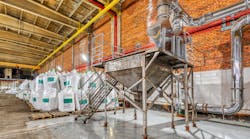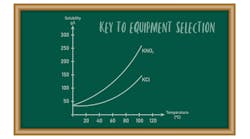My previous columns on major solids-processing technologies focused on separations. Crystallization gives us a purer product from a mixture of solids and fluids. Solid/liquid separation allows us to extract the high-purity material while drying removes the last traces of solvent. Each operation improves the quality of our product but at the expense of some of the product (i.e., due to attrition or agglomeration). This same issue continues when moving and delivering the product.
In my July 2017 column, “Run a Pneumatic Conveyor Test,” https://bit.ly/3sZ0nyR, I listed seven items to check when running a pneumatic conveyor test at a manufacturer’s facility. While I emphasized attrition as a watch-out, I only suggested looking at something similar to your intended layout. Before deciding on that layout, you should evaluate the number of elbows, transitions and straight-run lengths. (Most manufactures have computer programs that can help in that evaluation.) We had an existing pneumatic conveyor line with too many elbows. I suggested using a new line with fewer elbows to cover about the same distance and also spacing the elbows farther apart and eliminating a section where the line dropped down in elevation. In addition, because of the length of this dilute-phase conveyor, we expanded the line about two-thirds of the run length. This significantly reduced attrition, prompting the plant to modify the existing line.
The other side of attrition is agglomeration. In some cases, you must have a little attrition to create efficient agglomeration (see my January 2022 column: “Solidify Your Solids Processing,” https://bit.ly/3IV206K). However, agglomerated particles may not be strong enough to withstand intense handling. To avoid this issue, postpone particle separation until just before the product is put into bags. This allows the fine particles to protect the agglomerates during transport across the plant.
Screens often handle particle separation — but elutriation or even a fluid bed can do a better job. The fluid bed usually is less efficient but can serve as an agglomerator by adding a fine spray of solvent. While the emphasis in my October 2009 article, “Clamp Down on Clumping,” http://bit.ly/2OD2seS, was on preventing agglomeration, you can use the techniques to improve the particle size distribution.
How the customer samples and handles the product can create avoidable issues about meeting its specifications. So, it is important to agree on these items before sending out product. My favorite example of how not to sample is thief sampling; dipping the sampler into one compartment is not a good technique. The better way to deal with this problem is by providing a composite sample taken at the time of product loading.
We often forget that dust collection is an integral part of delivering a product. In bagging operations, we must maintain a clean working environment, with any dust going into the bag rather than on the bag or around the work area. Usually a bagging operation includes a built-in dust collection system. It could be a hood, push-pull or other local ventilation. Remember that a dust collection system also is a pneumatic conveyor: the gas velocity is all that is carrying the particles to the dust collector. In tightly fitted collection points, maintaining dust suspension requires adding extra air. What often is overlooked is balancing air flows, especially when using multiple bagging operations. Proper balancing is needed to ensure the dust is carried away from the work area. If it isn’t and the local velocity is too low, the system will plug up.
In addition, pay attention to the handling and storage of slurries and wet cakes, as mentioned in my November 2018 column, “Deftly Deal with Wet Cakes and Pastes,” https://bit.ly/3zJTDbP. These materials are troublesome to begin with but can suffer from attrition as well as phase changes and even color changes. For instance, we were surprised when a dryer product started showing a slight reddish color — but only on Monday’s production. It turned out that wet cake left from Friday’s production often was stored until Monday. To disperse the stored cake, a ribbon blender was used to feed the dryer. Unfortunately, an amine in the solids broke down over the weekend and caused the color change. We had to modify the union contract to finish all material on Friday.
Remember, the job is not done until your product is out the door.



